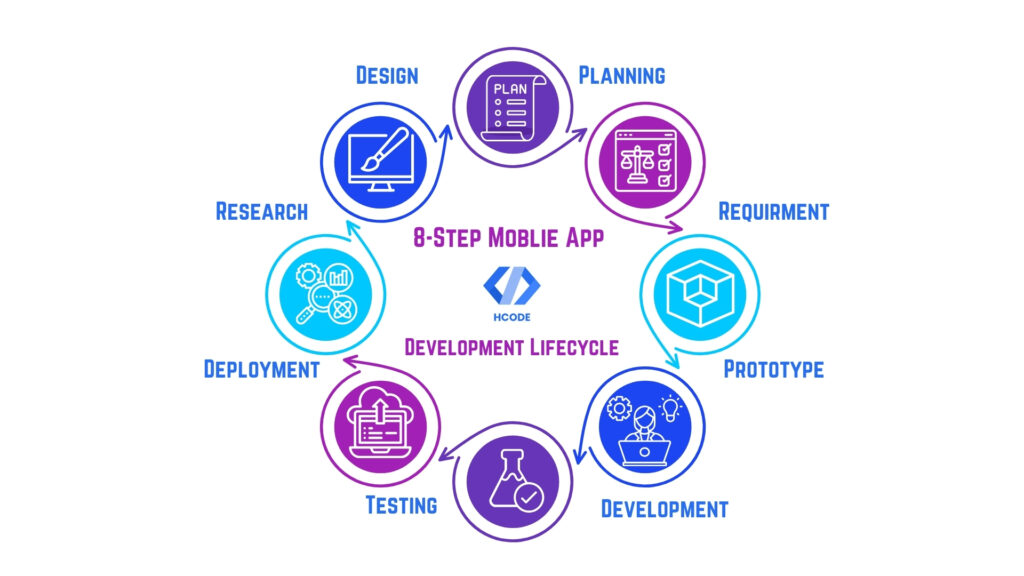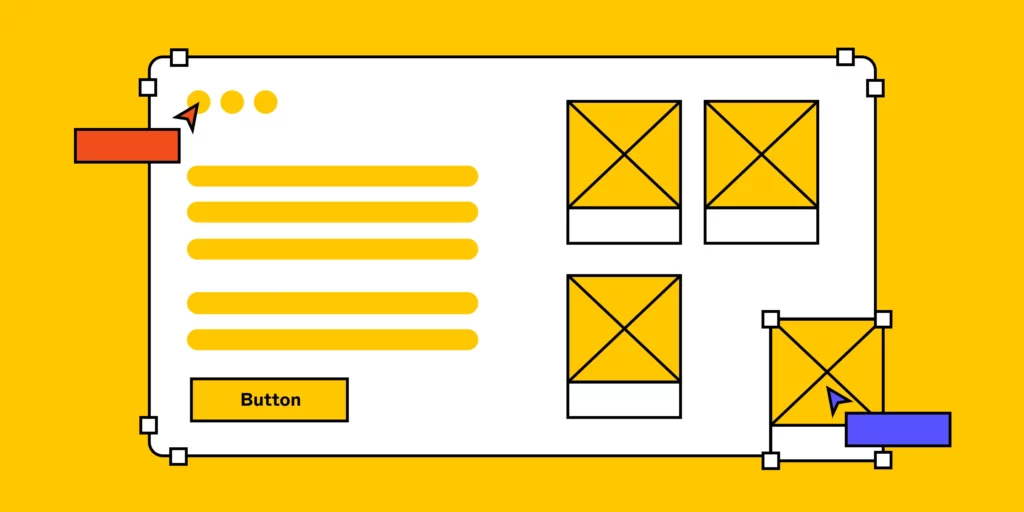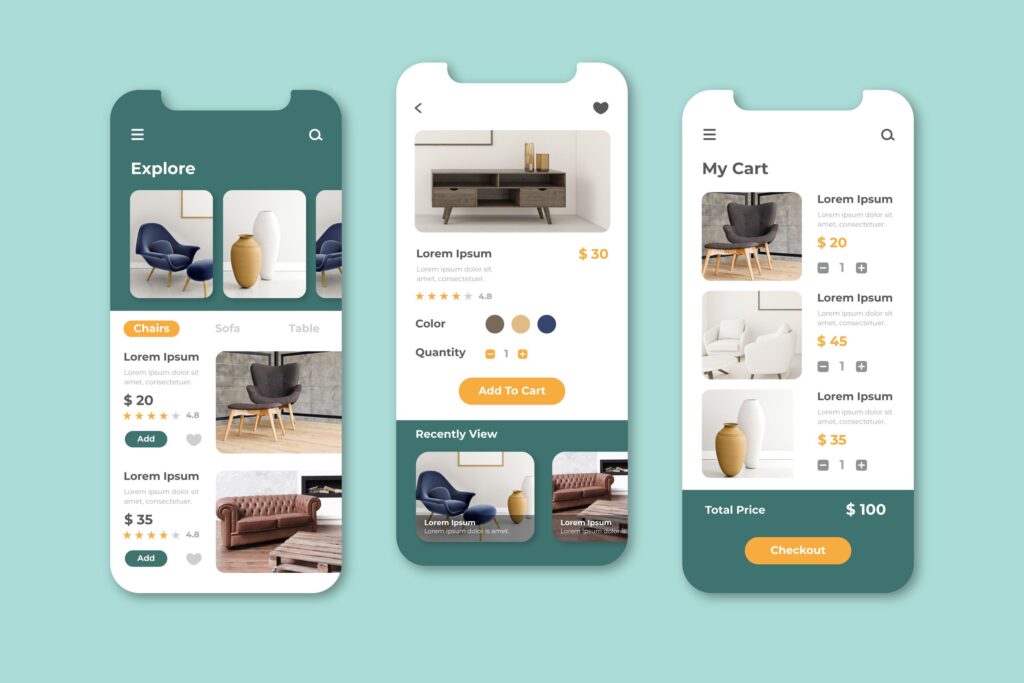Mobile App Development Lifecycle: Demystified

The mobile app market is booming, projected to reach a staggering US$673.80 billion by 2027. Businesses are eager to tap into this ever-growing audience, but standing out in a sea of over 1.6 million apps on the App Store alone is a challenge.
Developing a successful app requires a strategic and well-defined process. This blog post will serve as your guide, demystifying the stages of the mobile app development lifecycle with the expertise of HCode Technologies, a leading mobile app development services provider.
We will simplify the process of building a mobile app into eight clear steps. This will equip you with the knowledge to navigate potential challenges and pitfalls. We will explain the key concepts of app development, answering what goes into building a successful mobile app.
By the end of this, you will be empowered to create an app that not only thrives but potentially goes viral.
The 8-Step Mobile App Development Lifecycle with HCode Technologies
While an expert marketer will emphasize the importance of optimization for app success, a strong foundation is equally critical. The mobile app development lifecycle meticulously addresses these core elements, ensuring your app has a user-friendly interface (UI), seamless functionality, and scalability to handle future growth.
At HCode, we have developed a proven 8-step process for creating successful applications. In this guide, we will cover each step, providing you with the knowledge to navigate the app development journey and create an app that is poised for success.

Research
There will always be an app(s) like yours before you enter the market—or something similar. Don’t copy them directly, but learn what similar apps offer and what users love (or hate) about them.
Reviews are a gold mine of information, revealing what people want and need in an app. By understanding these things, you can create a unique app that addresses real user problems and stands out from the rest.
This research goes beyond just user needs. You also need to figure out the best way to build your app technically. This involves choosing the right tools and systems, like programming languages and databases.
This step also helps in identifying and prioritizing the main functionalities of your application. As it turns out, the Pareto principle applies in application development as well. It means twenty percent of your app’s functionality caters to up to eighty percent of your users’s needs, and vice versa.
Research helps you find the main functionalities affecting your ROI. Picking the right ones helps avoid problems later and ensures your app is built efficiently, ultimately costing less and making you more money (ROI).
Design
When we have identified key functionalities and areas with potential, we proceed to put them down on paper. By consulting our clients’ minds and working with a hands-on design team, we develop an aesthetically pleasing user interface (UI) that caters to the client’s imagination and user experience.

Credits: Figma
The process involves first-round meetings followed by wireframe discussions. After it is decided what interface elements will exist on key pages, the designing process begins. Expert front-end developers with years of experience develop modern application designs using tools such as Figma.
Planning
In parallel with project initiation, we’ll be developing a comprehensive project plan. This plan serves as the roadmap for the mobile app development, outlining key elements like timelines, the chosen technology stack (the tools we’ll use), any APIs we’ll integrate with, and of course, budget considerations.
We prefer and recommend agile development; thus, we prioritize clear and attainable deadlines alongside well-defined project goals. This necessitates a thorough discussion of priorities before we move on to development.
We all know application development is an iterative process; we develop, analyze, and refine based on the insights we gain. Therefore, the first release holds significant importance. During the planning phase, we’ll discuss features with the most pressing market release needs, data management strategies, technology stack selection, and all other factors that can influence project timeline and cost.
Requirement
App development projects tend to last months, if not years. In such a long time frame, things change. Market, preferences, ideas, and even employees. The addition of many uncertainties complicates projects day by day, a common challenge during application development.
To address this challenge, our team establishes a requirement phase, a pre-development documentation phase. In this phase, we discuss and document all the necessary details, including even fine details like process requirements, product requirements, and functional and non-functional requirements.
Cost estimation and timelines are documented along each phase of development while also mentioning project outlooks such as efficiency, flexibility, integrity, usability, maintainability, reusability, testability, reusability, and robustness.
Prototype
When both developers and clients agree on the requirement, development truly begins with building a prototype. A prototype helps you gauge the user’s experience with the application. There is no better way to find out the app’s credibility.

All decisions made to this point were based upon our perception and research, which can be very different from what our actual audience needs. The app materializes in the form of a prototype, providing us with feedback to improve the mobile app development process further.
Development
Our development team transforms the approved design elements and functionalities into functional code during this phase. They strictly adhere to established architecture and technical specifications.
Mobile app developers integrate APIs and other external services at this stage to extend the app’s capabilities and features. Throughout the coding process, developers conduct unit testing, which involves testing individual modules of code to identify and rectify any errors or bugs early on.
Quality Assurance (QA) Testing
A team of Quality Assurance (QA) experts meticulously tests the application on various devices, operating systems, and network conditions to ensure that it is free from bugs, performance issues, and usability problems. This comprehensive testing process is aimed at identifying and eliminating any issues before the app is released to the general public.
In some cases, a select group of target users may be involved in user acceptance testing (UAT). This testing involves real-world users who provide valuable feedback on the app’s usability, functionality, and overall user experience. The UAT phase is crucial in ensuring that the app meets the needs and expectations of its target audience.
Deployment
Developers submit the app to the appropriate app store, such as the Apple App Store or Google Play Store, after thorough testing to ensure it’s ready for release. The submission must follow the specific guidelines and approval processes of each app store. Once approved, the app is released for public use.
You’ve explored the crucial stages of the mobile app development lifecycle. Now you possess a valuable roadmap to navigate the exciting journey of creating your app.
However, the app market is a dynamic landscape, and a successful launch is just the beginning. At HCode Technologies, we understand the importance of ongoing support and strategic guidance. Our expertise extends beyond simply building your app; we partner with you to ensure its long-term success.
We believe in fostering a collaborative partnership, providing you with the expertise and resources to navigate the ever-evolving app landscape. Don’t hesitate to reach out to HCode Technologies; let’s discuss your vision and turn your app idea into a thriving reality.
